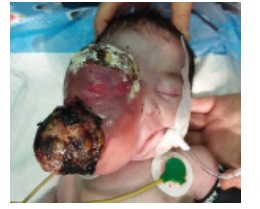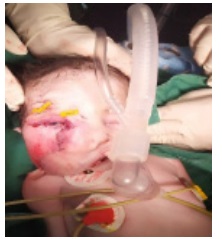
Journal of Clinical Images and Medical Case Reports
ISSN 2766-7820
Case Report - Open Access, Volume 3
Congenital orbital malignant tumor in a neonate: Anesthetic management
Alireza Ebrahimsoltani1; Naghmeh Nikzad2; Bita Malekianzadeh1*
1 Anesthesiology Department, School of Medicine, Tehran University of Medical Sciences, Tehran, Iran.
2 Children’s Medical Center, Tehran University Medical Sciences, Tehran, Iran.
*Corresponding Author: Bita Malekianzadeh
Assistant Professor of Anesthesiology Department,
School of Medicine, Tehran University of Medical
Sciences, Tehran, Iran.
Email: malekian.bita@yahoo.com
Received : Nov 25, 2021
Accepted : Jan 13, 2022
Published : Jan 20, 2022
Archived : www.jcimcr.org
Copyright : © Malekianzadeh B (2022).
Abstract
Congenital malignant neonatal tumors are rare and different from the tumors observed in older children and adults. Multimodal treatments such as surgery are required to remove these tumors. Neonates are the most vulnerable patients from anesthesiologists’ perspectives. We present a neonate with a massive malignant orbital round cell tumor. A 13-day male neonate presented with a huge congenital mass on the right side of his face. The necrotizing and bleeding tumor was successfully removed in a four-hour surgery. However, airway management and massive bleeding were challenging for the anesthesiologist. Huge congenital tumors on the head and neck of neonates are challenging clinical cases for anesthesiologists due to the possibility of airway problems, excessive bleeding, and immaturity of neonates.
Keywords: congenital round cell tumor; massive transfusion.
Citation: Ebrahimsoltani A, Nikzad N, Malekianzadeh B. Congenital orbital malignant tumor in a neonate: Anesthetic management. J Clin Images Med Case Rep. 2022; 3(1): 1595.
Introduction
Neonatal tumors are clinically diagnosed before the first month of life. Some of them are congenital and exist at birth. Since neonatal neoplasms account for 2% of all pediatric tumors, neonatal neoplasms are considered to be rare. Its incidence is estimated to be 2.8-3.74 cases per 100000 newborns per year. Perinatal tumors are different from the tumors commonly found in older children and adults in terms of pathogenesis, behavior, response to treatment, and outcome [1]. The most common neonatal tumors include neuroblastoma, CNS tumors, retinoblastoma, sacrococcygealteratoma, and other rare tumors such as leukemia, renal tumors, and sarcoma [2]. Malignant round cell tumors are extremely malignant and aggressive with poor prognosis. Congenital undifferentiated sarcoma is a subgroup of round cell tumors. It is a rare tumor on which a handful of research studies have been done [3,4]. Its true incidence is largely unknown. We present a rare case of congenital orbital malignant round cell tumor in a neonate and discuss its anesthesia management.
Case presentation
A few hours after birth, a male neonate with a huge congenital mass of the face was admitted to a tertiary pediatric hospital. The neonate was full term and he was born via Natural Vaginal Delivery (NVD). The parents were neither consanguineous nor have a history of genetic disorders or malignancy in their previous offspring. The tumor was diagnosed in pregnancy ultrasound and its dimensions were 10 X 15 cm (Figure 1). The tumor was extended from the lower eyebrows and globe to the right mandible and chin. It was necrotizing that adversely affected the right lip, philtrum and, nasal bridge. Due to frequent bleeding, hemoglobin decreased during NICU care and compatible pack cells with the blood of mother and neonate were transfused several times. Chitotech powder was poured over the surface of the lesion to cover it. Two days before surgery the patient was intubated due to respiratory distress in the operating room. Bag mask ventilation was so difficult due to the location of the mass. However, the patient was sedated with oxygen and sevoflurane through Mapleson D and a size 3 uncuffed endotracheal tube was inserted. Cormack-Lehane Scoring System (MCLS) of laryngoscopic views was. He received dopamine infusion due to variable blood pressure in the NICU. His weight was 2800 grams. Lab data: WBC: 2800/ µl, Hb: 14.8 g/dl, Plt: 87000/ mm3 . The other lab data, electrolytes, and coagulation tests were within the normal range. After monitoring and access to a central line, induction with sevoflurane was performed and we continued anesthesia with atracurium, isoflurane, and fentanyl administration. The patient was ventilated with pressure control ventilation mode and Mapleson D, alternately. Tumor debulking and lateral tarsorrhaphy were performed by a pediatric surgeon and an oculoplastic surgeon during a 4-hours surgery (Figure 2). The globe was kept intact. During the surgery blood loss was estimated to be the blood volume of the neonate. His blood volume was approximately 250 cc. Pack red blood cells 150 cc, ffP40 cc, and 1 unit of platelet were transfused during the 4 hours. Massive transfusion was inevitably done. Calcium gluconate 50 mg and fibrinogen 150 mg were also administrated. The patient received dopamine infusion during surgery and his hemodynamic and arterial oxygen saturation were stable. Blood gas analysis showed mild mixed acidosis: PH: 7.19, PCO2 : 53.8, HCO3 : 20.2, BE:-8.5, PO2 : 129 mmHg. At the end of the surgery, the intubated patient was transferred to NICU. The lab data after surgery: Hb: 9.7 g/dl, Hct: 30.6, WBC: 3200/ µl, Plt: 98000/ mm3 . Coagulation tests and serum electrolytes were within in normal range. The patient did not have any massive transfusion complications and he was extubated 4 days after surgery. Continue treatment included chemotherapy and intensive care.
Discussion
Huge congenital neonatal tumors are rare. The most common types of these tumors includes sacrococcygeal teratoma, sarcoma, mesenchymal tumors, hemangioendothelioma [1,5]. Undifferentiated sarcoma is a subtype of round cell tumors with mesenchyme origin. Huge head and neck tumors are challenging for anesthesiologists due to airway and ventilation problems and the possibility of massive bleeding. In 1962 the first report of orbital undifferentiated sarcoma in a six-day neonate was published. Subsequent reports on this neonatal tumor are limited and most studies concentrate on neonatal teratoma [6,7]. Airway invasion and compression should be considered in these patients. Anticipated difficult airway in neonates can be managed through using the modern devices including videolaryngoscope, supraglottic airway devices and flexible fiberoptic scope. Inhalation sedation, intravenous general anesthesia and awake technique have been used before application of these devices. The method selection is related to the patient anatomy, tendency to spontaneous ventilation reserve and bag mask ventilation ability [8,9]. Huge tumor mortality and morbidity are due to hemorrhage, hypothermia, coagulopathy, extensive transfusion, and related complications [10-12]. Mortality and morbidity in neonates are higher than in older children and adults [13]. Massive transfusion in neonates is defined as the replacement of one/ greater than one volume during 24 hours or half of a blood volume in 12 hours or higher than 10% TBV (Total Blood Volume) in a minute [14]. Different protocols have been proposed for massive transfusion in neonates and children, but data is limited and further studies on optimal transfusion approachesare needed. As in adults, massive transfusion entails risks ranging from mild side effects to lethal complications in neonates [15]. Bleeding during surgery is usually anticipated. In response to the patient’s bleeding and hemodynamic condition, we administrated Pack red blood cells: 150 cc, ffP: 15 cc/kg, and Plt: 0.3 u/kg. Massive transfusion complications in neonates are allergic and immunologic reactions, metabolic derangement such as hypocalcemia, hypomagnesemia, hyperkalemia, hypokalemia, metabolic alkalosis, acidosis, hypo and hyperglycemia, hypothermia, infection, TACO (Transfusion Associated Circulatory Overload), TANEC (Transfusion Associated Necrotizing Enterocolitis). Therefore, ongoing close monitoring is needed for neonatal massive transfusion. In this case, no complications were seen. The age of blood products and their freshness are very important in reducing MT complications. We tried to use fresh blood products. Conventional coagulation lab tests (PT, PTT, INR, and fibrinogen level) have limited value and provide partial information. Compared to conventional tests, point-ofcare global hemostatic assays especially TEG and ROTEM are preferred. Currently, no reference ranges exist for all ROTEM assays in neonates and studies are insufficient in this regard. We did not have access to these point of care tests [16,17].
Conclusion
Malignant small round cell tumor is a rare neoplasm in neonates, especially in the head and neck. We present a 13- daymale neonate with huge orbital undifferentiated sarcoma and discussed anesthesia challenges including airway problems, massive bleeding, and massive transfusion.
Declarations
Acknowledgment: None.
Conflict of interest: The authors have no conflicts of interest to disclose.
Informed consent: Written informed consent has obtained from the patient’s parents.
References
- Iatrou I, Theologie-Lygidakis N Fau - Tzerbos F, Tzerbos F Fau - Schoinohoriti OK, Schoinohoriti OK. Oro-facial tumours and tumour-like lesions in Greek children and adolescents: An 11-year retrospective study (1878-4119 (Electronic)).
- Solanki S, Menon P, Samujh R, Gupta K, Rao KLN, et al. Clinical Presentation and Surgical Management of Neonatal Tumors: Retrospective Analysis. (0971-9261 (Print)).
- Jin SG, Jiang XP, Zhong L. Congenital Ewing’s Sarcoma/Peripheral Primitive Neuroectodermal Tumor: A Case Report and Review of the Literature. (2212-1692 (Electronic)).
- Alfaro Cervello C, Andrade Gamarra V, Nieto G, Navarro L, Martín Vañó S, et al. Congenital undifferentiated sarcoma associated to BCOR-CCNB3 gene fusion. (1618-0631 (Electronic)).
- Raciborska A, Bilska K, Węcławek Tompol J, Ussowicz M, Pogorzała M, Janowska J, et al. Solid Cancers in the Premature and the Newborn: Report of Three National Referral Centers. Pediatrics & Neonatology. 2016; 57: 295-301.
- Mendelblatt FI, Renpenning HJ. Congenital Undifferentiated Orbital Sarcoma. Archives of Ophthalmology. 1964; 71: 459-462.
- Tuncer S, Kebudi R Fau - Peksayar G, Peksayar G Fau - Demiryont M, Demiryont M Fau - Cizmeci O, Cizmeci O Fau - Ayan I, Ayan I Fau - Gorgun O, et al. Congenital mesenchymal chondrosarcoma of the orbit: Case report and review of the literature. (0161- 6420 (Print)).
- Jagannathan N, Asai T. Difficult airway management: Children are different from adults, and neonates are different from children! Br J Anaesth. 2021; 126: 1086-1088.
- Sawa T, Kainuma A, Akiyama K, Kinoshita M, Shibasaki M, et al. Difficult Airway Management in Neonates and Infants: Knowledge of Devices and a Device-Oriented Strategy.
- Kim H, Kim HS, Oh JT, Lee JR. Anesthetic management for neonate with giant cystic hygroma involved upper airway -A case report. Korean J Anesthesiol. 2011; 60: 209-213.
- Nakano T, Kanemura N Fau - Aiba T, Aiba T Fau - Amatsu H, Amatsu H Fau - Kosimo N, Kosimo N Fau - Kinoshita A, Kinoshita A Fau - Uemura G, et al. [A case of a large neonatal pharyngeal teratoma]. (0030-6622 (Print)).
- Abraham E, Parray T, Ghafoor A. Complications with massive sacrococcygeal tumor resection on a premature neonate. Journal of Anesthesia. 2010; 24: 951-954.
- Kuan CC, Shaw SJ. Anesthesia for Major Surgery in the Neonate. (1932-2275 (Print)).
- Chidester SJ, Williams N, Wang W, Groner JI. A pediatric massive transfusion protocol. J Trauma Acute Care Surg. 2012; 73: 1273- 1277.
- Diab YA, Wong Ec Fau Luban NLC, Luban NL. Massive transfusion in children and neonates. (1365-2141 (Electronic)).
- Sokou R, Foudoulaki-Paparizos L, Lytras T, Konstantinidi A, Theodoraki M, Lambadaridis I, et al. Reference ranges of thromboelastometry in healthy full-term and pre-term neonates. (1437- 4331 (Electronic)).
- Theodoraki M, Sokou R, Valsami S, Iliodromiti Z, Pouliakis AAO, Parastatidou S, et al. Reference Values of Thrombolastometry Parameters in Healthy Term Neonates. LID - 10.3390/children7120259 [doi] LID - 259. (2227-9067 (Print)).


